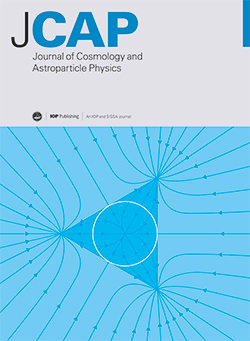Neutrino cosmology after DESI: tightest mass upper limits, preference for the normal ordering, and tension with terrestrial observations
IF 5.3
2区 物理与天体物理
Q1 ASTRONOMY & ASTROPHYSICS
Journal of Cosmology and Astroparticle Physics
Pub Date : 2025-01-31
DOI:10.1088/1475-7516/2025/01/153
引用次数: 0
Abstract
The recent DESI Baryon Acoustic Oscillation measurements have led to tight upper limits on the neutrino mass sum, potentially in tension with oscillation constraints requiring ∑ mν ≳ 0.06 eV. Under the physically motivated assumption of positive ∑ mν, we study the extent to which these limits are tightened by adding other available cosmological probes, and robustly quantify the preference for the normal mass ordering over the inverted one, as well as the tension between cosmological and terrestrial data. Combining DESI data with Cosmic Microwave Background measurements and several late-time background probes, the tightest 2σ limit we find without including a local H0 prior is ∑ mν < 0.05 eV. This leads to a strong preference for the normal ordering, with Bayes factor relative to the inverted one of 46.5. Depending on the dataset combination and tension metric adopted, we quantify the tension between cosmological and terrestrial observations as ranging between 2.5σ and 5σ. These results are strenghtened when allowing for a time-varying dark energy component with equation of state lying in the physically motivated non-phantom regime, w(z) ≥ -1, highlighting an interesting synergy between the nature of dark energy and laboratory probes of the mass ordering. If these tensions persist and cannot be attributed to systematics, either or both standard neutrino (particle) physics or the underlying cosmological model will have to be questioned.求助全文
约1分钟内获得全文
求助全文
来源期刊

Journal of Cosmology and Astroparticle Physics
地学天文-天文与天体物理
CiteScore
10.20
自引率
23.40%
发文量
632
审稿时长
1 months
期刊介绍:
Journal of Cosmology and Astroparticle Physics (JCAP) encompasses theoretical, observational and experimental areas as well as computation and simulation. The journal covers the latest developments in the theory of all fundamental interactions and their cosmological implications (e.g. M-theory and cosmology, brane cosmology). JCAP''s coverage also includes topics such as formation, dynamics and clustering of galaxies, pre-galactic star formation, x-ray astronomy, radio astronomy, gravitational lensing, active galactic nuclei, intergalactic and interstellar matter.
 求助内容:
求助内容: 应助结果提醒方式:
应助结果提醒方式:


